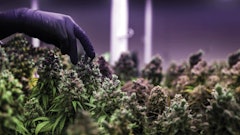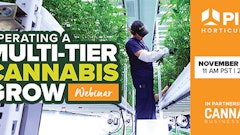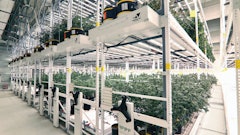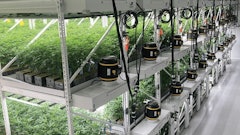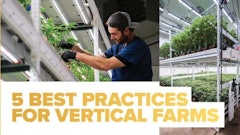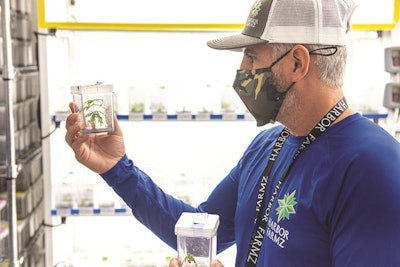
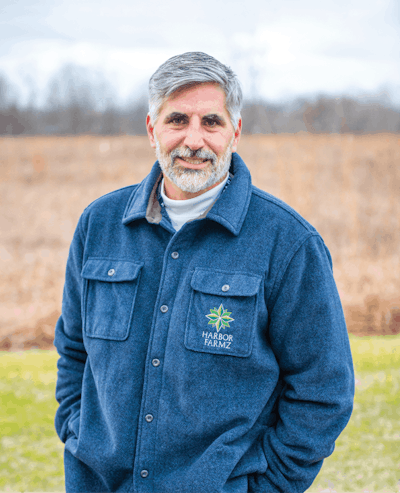
Michael Ward, CEO and founder, Harbor Farmz.
All photos by Everett McMillen Cislo
Everyone in the industry told Michael Ward he was crazy.
While his cultivation team at Harbor Farmz planned their first harvest last fall, Ward, the CEO and founder of the cannabis business in Kalamazoo, Mich., heard over and over again that it would take a week to take down a three-tier, vertical-grow flower room. But he was determined to do it faster. Even his own head grower, Chris Teeters, told him it was a leap. The night before the big day, Teeters didn’t sleep.
On Nov. 30, however, the team finished its harvest in six hours: Purple Urkle plants were cut and hung, and the organic living soil was brought out back for composting. The room was ready to clean. The mood was celebratory and, in a way, paradigm-shifting. The possibilities became clearer.
As everyone in the industry knows, time moves fast around here. Harbor Farmz is out to prove something in Michigan’s rapidly expanding marketplace—that craft cannabis can be produced at a scale and a speed that lifts the bottom line and surprises even the most probing connoisseurs.
“As we get better at our efficiencies in planting, transplanting, taking down a room, cleaning a room—every time we can get a day back, it adds up quick,” Ward says. “And you extrapolate the time gained over this many rooms. It adds up quickly.”
Ward walks through the Harbor Farmz facility, training his hazel eyes—framed by shocks of salt-and-pepper hair—to the plants and scanning from floor to ceiling, stopping to talk with staffers about air flow or moisture measurements, doing his best to be heard through the requisite face mask that obscures his mouth and closely cropped beard. The building, all 36,000 square feet of it, includes 11 flower rooms—each one 480 square feet (and one dedicated to research and development). The first harvest was a big step, but now Harbor Farmz is enmeshed in a perpetual harvest cycle. The hurdles keep coming. As goals are achieved, time moves even faster.

Walking through the facility in the team’s distinct, bright blue uniform, it seems like Ward relishes the pace of it all. There’s a certain centripetal force at Harbor Farmz: The team of 35 employees hews to Ward’s vision for what is possible in the cannabis industry. Assembled from their own diverse backgrounds, the team has gathered in Kalamazoo to test hypotheses and deliver a unique suite of genetics to the Michigan marketplace. There are things in this building, Ward promises, that Michigan hasn’t seen yet.
“I’m not just hiring cannabis-specific people,” he says. “By using other people’s skill sets and bringing their skill sets to cannabis, it really changes the game. I’m the redheaded stepchild of cannabis. I haven’t been a grower for 20 years, but I understand how to grow.” The double meaning of “grow” is not lost on the staff, which has tripled in size since late last summer.
In one flower room, Ward draws close to a Crunch Berries plant and inhales its sweet, gassy scent. Around him, a mix of Lemon Breath, Kimbo Kush and Purple Urkle stand tall and mighty. They’re about 10 days from harvest. Until then—and long after each plant has come down—every second counts.
Every week, Ward drives nearly three hours into Kalamazoo on Monday morning and leaves for home and family in Chicago Friday afternoon. He begins his weekdays by scanning the facility’s internal system on his computer over a hot cup of coffee. He and his team can monitor the entire Harbor Farmz building from anywhere. “I review the data history from the night before to make sure we do not have any temperature or humidity spikes,” he says. Then, it’s time to head to the office and get closer to the details.
The Harbor Farmz facility is located in Kalamazoo’s Davis Creek Business Park, a former brownfield refinery site that sat dormant and methane-ridden for more than a decade. It’s another reminder that cannabis can galvanize local economic development.
Before all of this came to be, Ward spent the past 21 years working with his father and brother at the family’s fourth-generation precision metal stamping business in Evanston, Ill. He says that the lessons he learned there—how to integrate economies of scale and granular workflow management into sweeping business models—are the same tenets around which Harbor Farmz orbits.
“I really understand manufacturing and production and movement,” he says. “Every time somebody touches something, it costs money. Every time you move that pot, I’m adding cost to this room. So, if you look at it in that approach, it’s always: How can I eliminate those costs and create better profit margins?”
A good example of this is the auto-potting machines that his team uses when transplanting crops.
“I asked myself, ‘How do we fill 324 pots?’” Ward says, referencing the three rows of three-tiered shelves in each of Harbor Farmz’s flower rooms. “I mean, imagine you’re going out back and you’re going to fill 324 pots for your patio or something like that. How are you going to do it?”
The answer was simple: twin auto-potting machines fill veg- and bloom-sized pots with the right amount of soil—with only the push of a pedal. There’s no human sloppiness to the process, and the soil is sent off for composting after harvest. The pots themselves are cleaned in an industrial-grade pot washing machine for sterilization and reused. This was one decision that ultimately removed hours and hours of labor.
But it took a long time to get to the point of charting transplant workflows. First, Ward needed to get into the industry.
Illinois clearly was shifting toward some sort of progressive cannabis policy in the mid- to late-2010s, but it was the long-running legacy of Michigan’s caregiver system and the impending switch to a regulated adult-use marketplace that seemed like a more attractive play. Ward and his longtime friend Mike Insco, now the director of cultivation for Harbor Farmz, began scouting Michigan municipalities that might be inclined to allow cannabis within their borders. In the early days of the state’s regulated medical cannabis market—in late 2016 and early 2017—this was no easy task.
It’s a common motif in new markets, the issue of whether individual local jurisdictions will “opt in” to the industry and allow sales within their borders. In Michigan’s medical landscape, the difference was particularly strident. It took a local ordinance to allow cannabis business activity in a given municipality, and in 2016, shortly after the medical cannabis market took off, opt-ins were few. “Seventy-five percent of the battle is finding someplace to be,” an accountant in the industry told mlive.com in 2017. When the state’s voters approved an adult-use market in 2018, the same local tension reappeared. As of December 2020, some 1,400 municipalities, or more than 75% of the state’s jurisdictions, have kept the door closed to cannabis sales, according to data from the Michigan Marijuana Regulatory Agency.
Kalamazoo, a brewery-friendly college town in the southwestern corner of the state, opted into the medical cannabis program early and arranged a zoning structure for the new industry.
In September 2019, Harbor Farmz broke ground on its cultivation and manufacturing facility. The next year, 2020, had plenty of surprises in store.
It’s not enough to say that the coronavirus pandemic has upended the cannabis business—the crisis and its attendant economic uncertainties have turned the entire world upside-down. But for Harbor Farmz, the timing could have been worse. The team was only just getting started, working with the city of Kalamazoo to convert its medical cultivation licenses to adult-use in the summer of 2020.
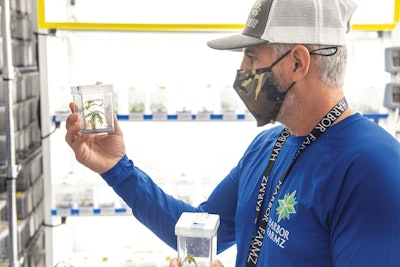
As the world was adapting and mostly staying indoors, Ward was able to focus on getting into the building in the first place (which happened in July) and then implementing short- and long-term plans before his products landed on shelves at dispensaries. As always, Ward’s mind was on the ticking clock hovering just out of frame.
“We’re focused on, first of all, eight-week strains,” Ward says after the company’s first successful harvest. “We want to turn these rooms every eight weeks. And every eight weeks puts me at around five and a half turns a year, per room. When I built this business model, I based it on three and a half. So, in a very short period, we’ve been able to ramp up exactly what we want to do by picking the right cultivars for yield, vigor and speed of growth. And for marketability.”
Teeters echoes this carefully calibrated mix of high-grade cultivation and business savvy.
“My biggest goal is to crush yields,” Teeters says. “This is business. [I want to] grow top-tier cannabis and still maximize production and yields. If we harvest the Purple Urkle this month and then we harvest Purple Urkle in two months, my expectation is that I have a better harvest two months from now than I did previously—consistently progressing.”
The team’s second harvest, on Dec. 7, took four hours. Seconds and minutes were already being lopped off the bottom line of these crop cycles. The whole team could feel a sense of accomplishment, a sense of focus.
“After we completed the first harvest, we gathered together to discuss what we can do better and how we can streamline the process,” Ward says. “One thing that really contributed to the reduction in time was doubling up on the hanging ropes for dropping plants down to be weighed. By adding two more lines to drop plants, we essentially tripled productivity.”
Of course, the ramifications of the coronavirus pandemic are felt throughout. Face masks are worn by all staffers. Visitors are screened for their temperature. It’s one thing to air-five a fellow employee, but it’s another thing to want an outlet for all the good news and accomplishments.
“We can’t celebrate anything for the most part,” Mark Milliman, Harbor Farmz’s president and longtime friend of Ward, says. “And we will celebrate success in the new year. Success is coming at a big level. We can feel it. … Unfortunately, we can’t do anything. I mean, we can’t even—it’s too cold to even assemble outside, nor would we be that foolish. But when this is all over and done, I certainly want to make sure that the culture of the company understands that we will celebrate success.”

For Teeters, success is a process of blending inventory management acumen with his decades of growing cannabis in California and elsewhere. He cut his teeth in the West Coast scene long before moving to Michigan and running a medical provisioning center. Sales started sliding in the early days of the coronavirus lockdown before owners sold the business. His path brought him to Harbor Farmz on the cultivation side.
It’s pattern recognition on Ward’s part, too: You need the business acumen and the cultivation expertise to match up culturally and financially.
As a CEO settling into a new industry, Ward is not the kind of guy who sits behind his desk. He doesn’t stop for a midday break. (“Lunch is a distraction that just slows my day down,” he says.) He enjoys walking room to room, inspecting the plants and fine-tuning air flow numbers.
“I am sure the grow team loves this, but I can assure you I find everything,” he says. “With 20-plus years of working in a manufacturing facility making millions of parts being held to a millionth-of-an-inch tolerance, I can most likely find a flaw in almost anything. From a mishandled branch, a broken branch, PM, IPM issues ... not much gets by me anymore.”
A lot of this comes from the work that Ward put in before ever approaching the state for licensing. He spent four years criss-crossing North America and touring facilities of all stripes. “I took the best and left the rest,” he says, thinking back to the conversations with growers and industry stakeholders that led him to the present.
Arranged on shelves in the brightly lit tissue culture lab at the heart of the facility are minuscule cuts of Crunch Berries, Stardawg, Lemon Breath, ChemDawg, Cookies, Mythical Blueberry #3 and Hana Mama, an elusive Korean cultivar Ward says his friend’s mother grew for decades in Maui. The diminutive scale of these cuts belies the importance of the lab: It is here where the long-term vitality of Harbor Farmz takes root.
Deb Sweeney, tissue culture lab director, says that cannabis has provided a natural outlet for her microbiology background and years of experience in the pharmaceutical industry. She uses a gel-based media unique to each cultivar, tending to meristems and nodes, monitoring their growth to ensure consistent development without unwanted genetic surprises. It can take months to stabilize an individual cultivar.
The meristem is a type of tissue found in plants, where undifferentiated cells divide and grow. These small cuts of plants are held in clean containers and used for micropropagation. It’s an efficient and expedient way to generate a good understanding of a particular cultivar, all the better to hone its genetic advantages for plant health and for the broader consumer market. With that process humming along within the facility, an in-house tissue culture lab is an asset that can provide tremendous returns down the line.
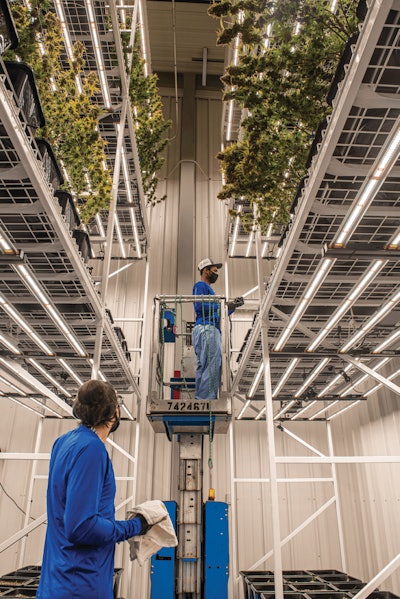
“You really want to have the cleanest, most audacious, most optimal way to grow,” Sweeney says. “You can take one teeny tiny meristem and grow it all the way to a mother plant. So, instead of taking clones from all different mother plants, you can actually take clones from one meristematic mother plant, and, ultimately, they’re going to be the cleanest, best-looking plants.” That goal is on the horizon—only because of the initial investment in Harbor Farmz’s tissue culture lab.
It also serves as a genetic bank, where Harbor Farmz can clean and house its own library of exclusive phenotypes and lease shelf space to other Michigan businesses interested in cleaning and storing cuts for posterity.
Because these are immature plants, too, they exist outside the scope of METRC’s track-and-trace system. “The amount of money you save on energy and labor keeping 700 plants in a Petri dish as opposed to 700 plants in 15 mom rooms—the expenditures on that alone are astronomical,” Teeters says. “When they come through these meristems, one, we’re certain that they have no systemic issues, and, again, it’s going to be a much more vigorous plant than it was when it came in as a clone.”
He mentions a cut of Triangle Kush that he’d held onto for more than 20 years at this point, and the genetic drift has slowed its growth and stunted its finest qualities; bringing it through the lab and working on its meristem culture, however, that genetic lineage is revived once it returns to soil. “It’s going to grow like it did in 1992,” Teeters says.The genetic bank gives the company some serious room to stretch. What the Harbor Farmz team is preparing in its arsenal is a wide-ranging library of genetics that simply aren’t seen in the Michigan market. And they won’t show up on shelves until they’re just right.
In the company’s R&D flower room, dubbed “F11,” Kyle Russell, Harbor Farmz’s director of breeding and genetics who was once a registered caregiver in Michigan’s medical program, scans more than 60 cultivars presently blooming. He’s pheno-hunting, watching for different characteristics to sprout from different seeds. The best phenotypes will make it to the mother room. It’s a meticulous process that guides downstream cultivation plans.
“You bring them in F11, you see and understand how they’re going to grow during the full cycle,” Ward says. “And you can see some showstoppers right out of the gate.” He points to Rainbow Runtz plants of different sizes—one coming in a little on the short side, but another coming in with striking color and full-bodied flowers.
It’s this process, soup to nuts, that will help Harbor Farmz stake its claim in Michigan. To use the insights gleaned from tissue culture to produce high-quality cannabis products at scale—that will demonstrate the core of Ward’s business model.
Sweeney says her goal from the beginning has been simple: “From meristem to mother.”
In mid-December, Ward reported that meristem mothers were now growing in Mother Room 2. “Mission accomplished!”
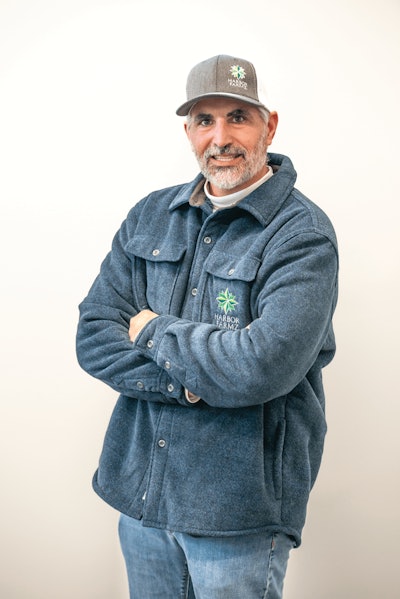
On Dec. 9, nine days after that first Purple Urkle crop was cut, the Harbor Farmz team is back at it for their third harvest. It’s a sunny morning in Kalamazoo, and the staff starts cutting plants at 8:30 a.m. As the day progresses, the scissor lifts go up and the plants come down.
By 11 a.m., they’re done. Two and a half hours.
“We’ll be back and running in this room by Friday,” Ward says, walking among the team and scouting the cleared-out flower room. It’s Wednesday.
Celebrations will come, as Milliman described, but this rapid-fire improvement—an almost exponential difference in the time spent on harvest—is a testament to Ward’s early projections. If this is how things are going in late 2020, pandemic and all, Ward says, can you imagine what comes next?
“I just think that we are not even close to scratching the surface of where we are with the full potential of this team,” Ward says. “They’ve been so nervous, and because they’ve been dealing with the unknowns, because they’ve been working out the kinks with facility issues in a brand new building, we haven’t really allowed them to let the reins out.”
There’s a clear excitement in the air about the flower coming out of Harbor Farmz. And then there’s the processing lab.
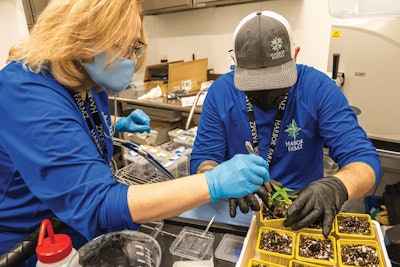
Shelves of non-infused gummies lay in experimental phases, the products of ongoing tests and recipe adjustments to perfect the products that will also shuttle out of this facility and into the Michigan market. Each harvest brings this side of the building closer to its inevitable buzz of activity.
Nick Wallace, lab director, says that the key to this high-demand segment of the business is extraction efficiency. He is a chemistry graduate of Michigan State University, and he spent time in the early medical days working with caregivers to dial in their concentrates for patients. Now, at Harbor Farmz, the same experience applies: It’s just at a whole new scale.
“That is what pushes you to the next level—to be able to really maintain your efficiency, have no waste and to really get your full value out of the product,” he says, describing the techniques involved in stripping every last bit of THC, whether 2% THC or 20%, off a batch of plant material.
He and Ward pull a sheet of diamond-riddled live resin out of a chiller, another product of the team’s hydrocarbon process. “We really take the time to grow all the crystals as slow as possible to preserve all the flavors,” Wallace says.
In another room, the Harbor Farmz ethanol extraction equipment is set up for gummies and vape carts. Here, a one-man operation could rip through 1,200 lbs. of plant material each month. That’s just the start of it. And, already, as Ward scans the room and plots his projections further in the future, he begins thinking of the best way to get from the present moment to the point where concentrates are flying out of the building. The shortest distance between two points is a straight line, of course, but that’s rarely the most efficient route.
“Honing in on the most efficient way of doings things—that’s the bread and butter for me,” Ward says—and although the mask is on, his eyes communicate a smile.









